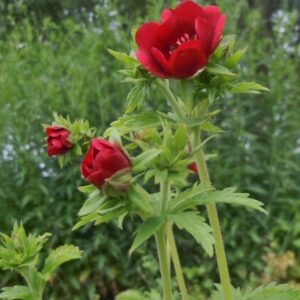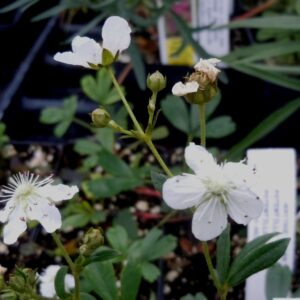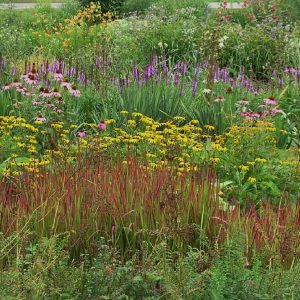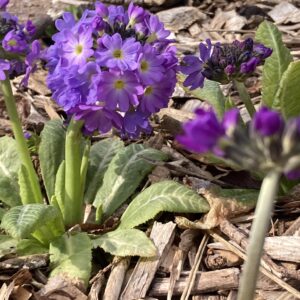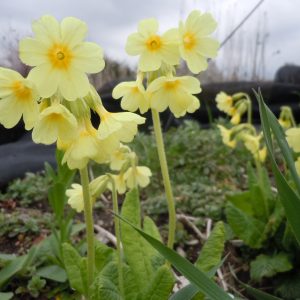Shop
Showing 585–592 of 778 results
-
Potentilla rupestris syn. Drymocallis rupestris Rock cinquefoil, Siberian tea Z 5-8
White, single rose-like saucer flowers with prominent yellow stamens in early summer.
White, single rose-like saucer flowers with prominent yellow stamens in early summer.
Size: 10-20" x 12"
Care: sun to part shade in well-drained to moist well-drained soil
Native: Europe, Asia & mountains of western No. AmericaPotentilla is Latin meaning “powerful” referring to medicinal properties. Rupestris means “rock loving.” This species 1st identified in literature in 1650. Russians used the leaves to brew tea.
-
Potentilla thurberi Scarlet cinquefoil Z 5-9
Loose clusters of Cabernet-like reddish purple saucers - June to September.
Loose clusters of Cabernet-like reddish purple saucers – June to September. Valuable for both its long bloom and its dark red flowers.
Size: 30" x 12"
Care: full sun in well-drained soil
Native: Arizona & New MexicoPotentilla is Latin meaning powerful referring to medicinal properties. This species collected before 1880’s.
-
Potentilla tridentata syn. Sibbaldiopsis tridentate Three-toothed cinquefoil Z 2-7
Clusters of white, single rose-like saucer flowers spring and early summer on this dainty-appearing perennial. Its glossy evergreen leaves tinge red in fall and winter.
Clusters of white, single rose-like saucer flowers spring and early summer on this dainty-appearing perennial. Its glossy evergreen leaves tinge red in fall and winter.
Size: 6" x 12" spreading by runners-can become a groundcover.
Care: sun in well-drained, acidic soil
Native: New England to Upper Great Lakes, north to the Arctic, Appalachian Mountains of Georgia, WI native.
Wildlife Value: source of food for Copper butterflies
Awards: Cary Award Distinctive Plants for New EnglandDescribed and named by Kew’s British botanist William Aiton in Hortus Kewensis 1789.
-
Potentilla x tonguei Staghorn cinquefoil Z. 5-8
Apricot-yellow flowers with red centers bloom June-September
Apricot-yellow flowers with red centers bloom June-September.
Size: 6” x 12”
Care: Sun to part shade in moist well-drained soil
Awards: Royal Horticultural Society Award of Garden Merit.This is a cross of P. anglica and P. nepalensis which took place naturally in a garden. This Cinquefoil has been in gardens since at least 1839. Potentilla is Latin meaning “powerful” referring to historic medicinal properties since Hippocrates. We love its long, colorful blooms and neat habit.
-
Prairie Garden
Prairie Garden
OUT OF STOCK
Note: This is a plant not currently for sale. This is an archive page preserved for informational use.Prairie Garden Size : Height x width* Bloom color
3 Agastache foeniculum – Anise hyssop 2-3’ x 12” purple
3 Allium cernuum – Prairie onion 12”-18”x 3-6” pink
1 Aster cordifolius – Blue wood aster 2-3’ x 2-3’ blue
3 Bouteloua gracilis – Blue grama 2’ x 12” purple tinge
1 Desmanthus illinoensis – Prairie mimosa 4’ x 3’ white
1 Eryngium yuccifolium – Rattlesnake master 48” x 18” white
1 Eupatorium sessilifolium – Upland boneset 3-4’ x 12-24” white
1 Euphorbia corollata – Flowering spurge 36”x 18” white
3 Geum triflorum – Prairie smoke 12”x 8” pink
1 Hystrix patula – Bottlebrush grass 2-3’ x 12-18” purple/green
1 Monarda fistulosa – Beebalm 3-4’ x 2’ purple
1 Parthenium integrifolium – Wild quinine 2-3’x 12” white
1 Solidago riddellii – Riddell’s goldenrod 3’ x 2’ yellow
3 Sporobolis heterolepsis – Prairie dropseed 2’ x 2’ orange-copper
All plants are perennials.
If planted together in one garden these make a 32 square foot garden. *Most of these plants get wider over time by spreading roots or by self-seeding .
24 plants for $213.47. Would be $251.15 if purchased separately. You save $37.67.
If you plan on coming to the Nursery to purchase this collection, please give us at least 24 hours notice to prepare the collection for you. -
Primula denticulata Drumstick primula Z 3-8
Spring-blooming ball, like a lollipop, purple or blue with a yellow eye, atop a leafless scape emerging from a base of wrinkled foliage
Spring-blooming ball, like a lollipop, purple or blue with a yellow eye, atop a leafless scape emerging from a base of wrinkled foliage,
Size: 12-18" x 12-18"
Care: Sun to shade in moist to moist well-drained soil.
Native: Afghanistan, N. Pakistan, across the Himalaya to Yunnan, Sichuan and Guizhou in China.
Wildlife Value: attracts butterflies, Deer and rabbit resistant.Collected by Dr. Frances Buchanan “in moist hills about Chitlong in Nepal.” Exotic Botany, vol. 2 (1805) Sir James Edward Smith (1759-1828) who purchased the huge cache of Linneus’ collection and founder of the Linnean Society. Knighted by Prince Regent for contributions to science.
-
Primula elatior Oxlip Z 4-9
Nodding trumpets of soft yellow flowers with a dark yellow center atop upright stems
OUT OF STOCK
Nodding trumpets of soft yellow flowers with a dark yellow center atop upright stems
Size: 10” x 10”
Care: part shade in moist to moist well-drained soil
Native: Europe
Wildlife Value: deer and rabbit resistant
Awards: Plant Select® Central Rocky Mountain region; Royal Botanical Society Award of Garden MeritPrimula is from Italian “primavera” meaning first spring. Elatior means “tall”, all things being relative it’s taller than some Primulas but not very tall. In gardens since at least 1765. According to Philip Miller, Gardener’s Dictionary 1768, “they are much used in medicine.” Grown at America’s 1st botanic garden, Elgin Botanic Garden 1811.
-
Primula japonica Japanese primrose, Candelabra primrose in Japan called Kurin-sou Z 4-8
White, red, pink or purple primrose flowers in early summer whorl around the leafless stem
OUT OF STOCK
White, pink or purple primrose flowers in early summer whorl around the leafless stem ending in a many-flowered clump on top. Basal mound of crinkled foliage.
Size: 18”x 18”
Care: sun to part shade in moist, acidic soil. Moist soil important.
Native: Japan
Awards: Elisabeth Carey Miller Botanical Garden Great Plant Pick.Introduced to Western gardens by Robert Fortune, English plant hunter, 1870 but Jan 1876 issue of The Garden reported that it was “introduced some years ago by Mr. Bull…” English plantsman, Listed in the 1873 catalog of Leichtlin’schen Gartens in Baden-Baden. Wm. Robinson called this “one of the best and most amiable of the species.” (1933)


